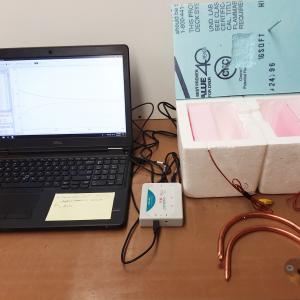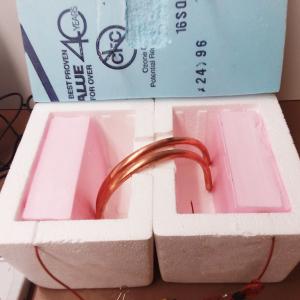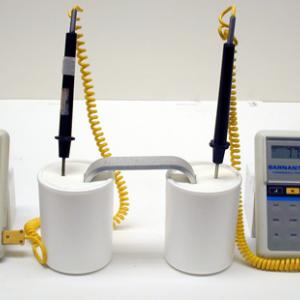College of Liberal Arts & Sciences
4B30.54 - Heat Transfer - Heat Pipe or Aluminum Bar
Put very hot to boiling water into one of the Styrofoam containers, and cold or ice water into the other. Make sure there is only water and no ice in the cold water reservoir. Place the heat pipes in the orientation indicated on the reservoirs and cover with the lid that has the thermometers inserted. Once the thermometers have come to a steady reading, you may start the data collection. The temperature readings should converge as the heat pipes transfer the heat from the hot to the cold reservoirs.
Put cold water in one cup and hot water in the other. Monitor the temperature over a period of time to plot heat transfer from one cup to the other.
- Georgios Stylos, Konstantinos Georgopoulos, Vasileios Nousis, Kanstantinos T. Kotsis, "Using Arduino in Introductory Thermal Energy Experiments - The Case of Thermal Equilibrium", TPT, Vol. 62, #8, Nov. 2024, p. 669.
- Roberto Rojas and Patricio Robles, "Graphic Representation of Quasi-Static Heat Exchange", TPT, Vol. 56, #6, Sept. 2018, p. 386.
- Albert A. Bartlett, "A Demonstration of Thermal Physics Using a Microwave Oven", TPT, Vol. 22, #9, Dec. 1984, p. 578.
- Joel L. Plawsky & Thao Nguyen, "Wickless Heat Pipes in Microgravity", Physics Today, Sept. 2017, p. 82.
- Jearl Walker, "4.64 - Heat Pipes and Potato Stickers", The Flying Circus of Physics, 2nd. Ed., p. 204.
- Julius Sumner Miller, Q128 & A128, Millergrams II – Some More Enchanting Questions for Enquiring Minds, p. 19 & 81.
Disclaimer: These demonstrations are provided only for illustrative use by persons affiliated with The University of Iowa and only under the direction of a trained instructor or physicist. The University of Iowa is not responsible for demonstrations performed by those using their own equipment or who choose to use this reference material for their own purpose. The demonstrations included here are within the public domain and can be found in materials contained in libraries, bookstores, and through electronic sources. Performing all or any portion of any of these demonstrations, with or without revisions not depicted here entails inherent risks. These risks include, without limitation, bodily injury (and possibly death), including risks to health that may be temporary or permanent and that may exacerbate a pre-existing medical condition; and property loss or damage. Anyone performing any part of these demonstrations, even with revisions, knowingly and voluntarily assumes all risks associated with them.



